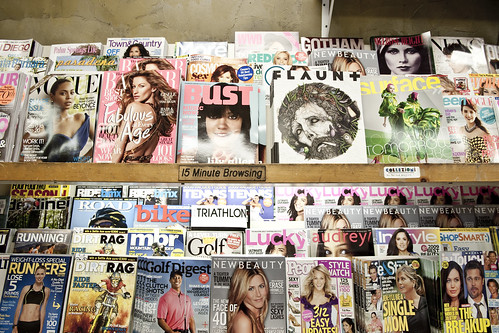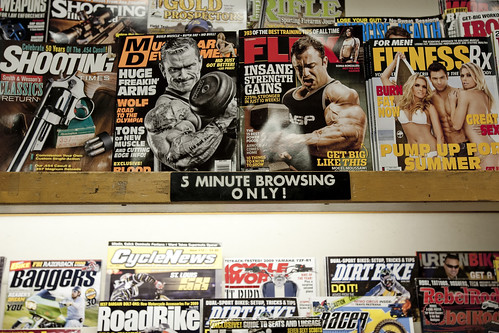Urban Scout Nicolas Nova (whose insights and conclusions on this same curious circumstance are here) and I spied this curious indentation in the cultural fabric of a local Santa Monica magazine stand, which, based on years of experience, is not known for its indulgent overlord. There is this peculiar hierarchy of browsing tolerances embodied in some raggedy, eye-level warning signage. These have a clear correlation to Maslow’s hierarchy of needs expressed in the limits one may have as to time spent perusing the thick, advertising-soaked magazines.
There is less time allowed for the physiological needs as expressed in the three minute limits for the filth, err..sex magazines; five minutes to quickly learn how to bulk-up with steroidal muscle so as to secure the safety of one’s person or find the proper riding technique for shooting from the hip while escaping riotous, foreclosed neighbors on a dirt bike; fifteen minutes for leisured indulgences in bolstering one’s self-regard by learning how to deliver an arrow-straight chip shot or dignify oneself with this season’s hippest trousers.
Why do I blog this? Intriguing rules and enforcement structures that embody social rituals. Even these simple rules about what you can read for specific amounts of time are curious to observe and ponder. The embodiment of the social rituals are erected through constraints on browsing time, the threat of enforcement from the Main Street Newsstand overlord, cautions against ripping him off, etc. Together, the browsing limits ultimately create observable meanings and opportunities for insights as to the specific nature of these corners of our interests, activities, hobbies, dispositions and so on.
Some questions that arise: What are the ways that culture is established and maintained through limits and threats, whether implicit or explicit? How do our needs and aspirations reflect themselves in everyday, quotidian rules, even the ones that are not necessarily stated as explicitly as these ones? How do rules, such as these, and admonishments, such as this one not to steal, which should be obvious, tell larger stories about the conditions of everyday life, as well as the mundane experiences of these simple facilities, like newsstands? How might these sorts of rules and limits be actualized in this context? Would the threat of transgressing the limits be enough, or must an enforcer dispense admonishments directly? How does this scenario play out in the near future of eInk magazines and Kindle 3.0? Would pages fade away after the browsing limit expires? In this case, would the rituals of browsing change directly if the limit is instrumented as a kind of security/enticement mechanism?


